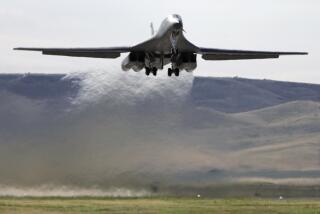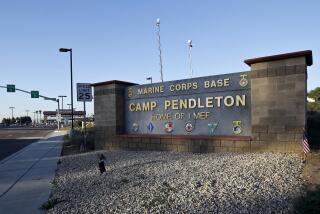Medical Choppers Not Immune to Iraq Perils
AL ASAD, Iraq — The helicopter crews of Iraq will tell you that their main concern is not so much the regular volleys of small-arms fire and rocket-propelled grenades hurled their way -- all potentially lethal should a shot find its mark. It’s the heat-seeking surface-to-air missiles.
“With a SAM, if you see the smoke trail and it’s going toward you, it’s usually too late,” Chief Warrant Officer Jason Coombes explained the other day on this sprawling desert base in western Iraq as the pilot headed out to his waiting Black Hawk. “But we can’t just up and quit. There’s a lot of people depending on us.”
These are edgy times for U.S. chopper crews in Iraq. Helicopters play a critical role here, but ground fire has forced down nine in the past three months, killing 49 soldiers, the Army says.
Two more pilots were missing Sunday when their OH-58 Kiowa Warrior helicopter crashed into the Tigris River in the northern city of Mosul during a rescue mission. Initial reports indicated that the crash was an accident. Sunday’s incident follows another apparent accident Friday in which two pilots were killed in Qayyarah, south of Mosul when their helicopter crashed in bad weather.
Among the victims this month were four members of Coombes’ unit, the 571st Medical Company, which is attached to the 3rd Armored Cavalry Regiment. The four were killed Jan. 8 when their Black Hawk medevac helicopter was hit near the restive city of Fallouja, west of Baghdad. Five U.S. military patients on board also were killed.
The 571st has flown more than 1,000 medevac missions, the vast majority without incident. But the unit has lost three helicopters. The latest crash underlined the daily peril the air corps face in Iraq, regardless of whether helicopters bear conspicuous red crosses and are shielded by the Geneva Convention.
“It opened up the eyes of a lot of people,” said Staff Sgt. Jonathan E. Spiller, a flight medic. “It was an unfortunate confirmation that, yes, the threat is still out there.”
It was also a time of deep anguish for the troops of the 571st, known as the Witchdoctors, one of five helicopter ambulance companies operating in the Iraqi theater. Each company is a close-knit group of about 150 soldiers, sharing both the camaraderie of deployment in a distant land and the distress of long-term separation from family, friends and familiar places.
All are bound in a singular mission: saving lives on the battlefield. Teams remain prepared to lift off on specially outfitted UH-60 Black Hawks -- absent the standard, door-mounted machine guns -- within eight minutes of an emergency call. Pilots have been schooled in evasive actions -- flying low and fast, varying flight patterns, performing nonessential missions at night.
“Everything we do, everything we work on every day, is focused on one thing: an aircraft landing and a medic getting out and placing their hands on someone who is injured,” said the 571st’s commander, Maj. William P. LaChance, 38, a veteran pilot. “There are soldiers all over Iraq, young kids, who have just been told they’re going out on a convoy, or are going out on a raid -- and they’re scared to death,” said LaChance, a father of two. “I somehow believe they do it because they know no matter what happens to them, no matter how, no matter where, if they get hurt, an aircraft with a red and white cross is going to come and get them.”
Once on the ground, the crews are pledged not to discriminate among victims. Their triage protocol focuses first on the most seriously injured, be they U.S. soldiers, enemy combatants or civilians.
In fact, the unit suffered its first losses of the war May 9, when a helicopter from the 571st tried to rescue an 11-year-old Iraqi boy who had stepped on a land mine near Samarra, north of Baghdad. The aircraft apparently dived to avoid enemy fire and hit an unseen cable strung across the Tigris, plunging into the river, LaChance said. Three crew members were killed.
Among those lost that day was Hans N. Gukeisen, the best friend of a soft-spoken company pilot, Ian D. Manuel. After the memorial service for his comrade in May, a shaken Manuel, from Jacksonville, Fla., sought out his commander.
“He had lost a great friend, was obviously shattered, and had a lot of doubts about his own courage to get back in the aircraft, to go back to doing those dangerous things his friend was doing,” LaChance recalled. “It was a perfectly natural human reaction.”
Soldiers are famously hesitant to acknowledge fear.
Manuel, who told friends that he joined the Army because he wanted to make a difference and follow in the footsteps of his grandfather, a bomber pilot in World War II, soon overcame his misgivings. He and his crew were awarded the prestigious Air Medal with Valor after landing in a hostile zone and evacuating injured personnel from a convoy that had been ambushed.
Manuel, a chief warrant officer, was back in the cockpit Jan. 8 as co-pilot of a 571st helicopter, Witchdoctor 11, transferring five patients from one Army medical facility to another. It was a routine mission -- though the helicopter did have to pass near Fallouja, where several aircraft had already been forced out of the sky. At about 2:20 p.m., the Army says, the Black Hawk was hit by ground fire, probably another shoulder-fired surface-to-air missile. Manuel, 23, was among the nine killed.
LaChance received the news at the unit’s unassuming command center here, where a stylized likeness of a witch doctor -- doing a Kabuki dance and brandishing a wrench and a medic’s kit -- greets visitors.
“So how do you feel?” LaChance said, repeating a visitor’s question with a clipped laugh. “I can tell you, it hurts bad.... You feel like you’ve been kicked in the gut. I was quite literally numb for a couple of days.”
It is the commander’s doleful task to call the victims’ families. “I can tell them what happened, I can tell them the condition of their loved one,” LaChance said. “I can tell them how he died. All those things that are difficult to say, yet they so desperately want to know.”
The flight medic on board, Spc. Michael A. DiRaimondo, 22, from Simi Valley, had come to Iraq as a ground medic. But he openly admired the adrenaline-jolting skill of his airborne counterparts.
“This is cool,” LaChance recalled him saying. “I got to do that.”
It was not so easy. Medevac commanders have a saying: If you don’t have a top medic, you may as well not fly. When DiRaimondo first came knocking at the door, he was told he lacked experience. But he didn’t give up, at one point asking a doctor acquaintance to intercede with the commander. Finally, his persistence paid off. DiRaimondo joined the 571st on Sept. 10.
His dedication during the rigorous training regimen impressed many of his fellow soldiers. The first major test came Nov. 2, when the 571st dispatched five helicopters to the site of a crash of a big CH-47 Chinook transport craft, also downed by a missile near Fallouja, the Army says.
“Junior, when we land on the ground, don’t be looking for me,” his superior told DiRaimondo en route to the site of the Chinook crash, LaChance recalled. “You’re on your own.”
Casualties were scattered among stunned survivors and twisted, burning wreckage. The engines of the downed Chinook were still hot. Volatile fuel had spilled, forming puddles on the ground. Sixteen died from the crash; 26 were hurt.
A rescue helicopter was about to leave the scene with a load of wounded, but no medical personnel. “We need to get a medic on board that Chinook!” came the call from a sergeant, La Chance recalled.
DiRaimondo, medical bag in hand, darted toward the rescue helicopter. He jumped inside, just before the doors shut and the aircraft took off, LaChance said.
“He was a natural: He just had the skills,” said flight medic Spiller, who trained DiRaimondo. “It wasn’t anything he learned.... Everything he touched just seemed to flow.”
Of the crash that killed DiRaimondo and the eight others, Spiller said: “Everybody was devastated. But we had to go out and do it all over again. We didn’t have a choice.”
A memorial service was held on the base three days later. It is a crucial ritual for soldiers coping with the loss of close friends.
“You remember them, and I feel that’s what they would want,” Chief Warrant Officer Coombes said. “They’d want us to remember them, but then just keeping doing what we’re doing.”
More to Read
Sign up for Essential California
The most important California stories and recommendations in your inbox every morning.
You may occasionally receive promotional content from the Los Angeles Times.










